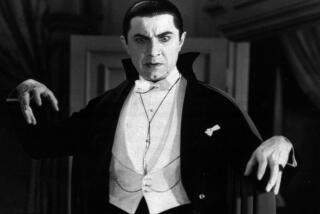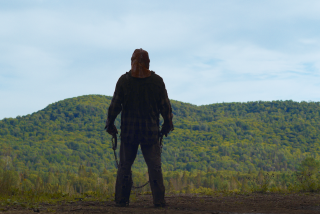Lifestyles of the undead
- Share via
“When there is no more room in hell, the dead will walk the Earth.” Ken Foree’s words chill your blood as the trailer for “Dawn of the Dead” flashes before your eyes: screaming victims, frantic news reports, collapsing police barricades. And suddenly there they are, zombies, the living dead! Bleeding, snarling, running ... running? Do zombies move that fast? And why aren’t they shouting “More brains!”? Don’t zombies eat brains? Are these even real zombies?
This question applies not only to Universal’s remake of George A. Romero’s zombie epic, which opens Friday, but all forms of walking corpses. The zombie’s star has risen from horror staple to pop culture icon -- but what truly defines the undead?
The word “zombie,” with roots dating back to ancient West Africa, has been used to mean everything from a voodoo snake god to a stagnant Japanese corporation. Cinematic zombies are even more nebulous. Each subsequent film, “Dawn of the Dead” being no exception, presents a new and contradictory depiction.
But careful analysis reveals that movie zombies can be distilled and classified into three distinct categories:
Orthodox zombies
Orthodox zombies are, unquestionably, the creation of writer-director Romero in his classic trilogy “Night of the Living Dead” (1968), “Dawn of the Dead” (1978) and “Day of the Dead” (1985).
Slow, awkward, bereft of intelligence and devoid of all but the most basic memories or emotions, they attack and devour the flesh of the living, swelling their ranks with mauled, reanimated victims.
Their origins are realistic and simple -- most likely a virus -- as is their one critical vulnerability, destruction of the brain.
In these three movies, Romero has created a set of rules so plausible and so globally accepted that Orthodox zombies remain the most numerous and universally recognized version. You can see them battling yakuza thugs in Japan’s “Junk” (2000), or wrestling a killer shark in Italy’s “Zombi 2” (1979).
Even today’s polished, MTV-esque “Resident Evil” (2002) is built upon Romero’s Orthodox zombie foundation.
Reform zombies
As with all established movements, there must inevitably be a revolution. It came with Reform zombies, a new breed of ghouls bearing little resemblance to the earlier shambling automatons.
Brains, not just any flesh, are the goal, while destruction of their own brains is no longer fatal. Their speech is human, as is their speed, agility and, in the case of Michael Jackson’s “Thriller,” their expert choreography.
These zombies defy not only the laws of Romero but also, apparently, the laws of nature. How else could a corpse missing its diaphragm, lungs and larynx still be able to gasp, “More brains”?
While the 1980s and early ‘90s seemed to be the heyday of Reform zombies, they reappeared in “House of the Dead” (2003), trapping a group of young hot teens on a haunted island where only the hottest survived. If “No more room in hell ... “ encapsulates the Orthodox, then nothing sums up these freer, hipper zombies better than their own slogan from 1985’s “Return of the Living Dead”: “They’re back from the grave, and ready to party!”
Conservative zombies
As with most revolutions, the pendulum swings back to the center. The ghouls inhabiting this remade -- and, many would argue, reinvented -- “Dawn of the Dead” represent a limited return to more traditional guidelines. These are the Conservative zombies, who combine Reform vigor with Orthodox logic.
With the exception of Olympian physical prowess, other aspects adhere to strict Romerian doctrine. Thoughtless, speechless, heartless flesh-eaters, Conservative zombies also share the Orthodox Achilles’ heel of a bullet (or sharp object) in the brain.
One school of thought maintains that Conservative zombies did not originate with “Dawn’s” remake but owe their beginnings (as with many cultural phenomena) to Britain, specifically director Danny Boyle’s smash hit “28 Days Later.” This is a fallacy. The psychotic, homicidal hordes of “28 Days Later” were not dead, and if all somnambulist scholars can agree on one basic truth, it is that to be a zombie, one must be clinically dead. Therefore, the “infected” of “28 Days” were not zombies at all, but more accurately “crazies.”
Do Conservative zombies represent a viable future for the living dead? Will they lead a parade of sequel and knockoff movies like their Reform and Orthodox predecessors? Or will they quickly be replaced by a new zombie, a ghoul with ever-changing characteristics to suit pop culture’s ever-changing whims? Only time and box office balance sheets will tell.
The living dead may continue to prowl mainstream consciousness for years to come, or they may retreat whence they came, back to their subculture shadows and narrow niche lairs.
Regardless, the zombie genre, like the creatures themselves, will never truly die. As America busies itself with some new craze, obsessed with its latest shiny distraction, the undead will wait, patiently, hungrily, for the day they rise again.
Max Brooks is the author of “The Zombie Survival Guide: Complete Protection from the Living Dead” (Three Rivers Press, 2003).
*
(BEGIN TEXT OF INFOBOX)
Best of the living dead
Top 10 Zombie Movies
1. Night of the Living Dead (USA, 1968) -- A farmhouse besieged by the undead, a genre is born.
2. Dawn of the Dead (USA, 1978) -- As society crumbles, zombies wander through a shopping mall like ... well ... like zombies.
3. Day of the Dead (USA, 1985) -- Humans holed up in a bunker not dealing with the problem right outside their door. Go figure.
4. Zombie 2 (Italy, 1979) -- No social subtext whatsoever, just a zombie fighting a shark.
5. Night of the Living Dead (USA, remake 1990) -- New director, same story.
6. Night of the Zombies (Italy, 1981) -- Fake Italian gore, but with real cannibal footage.
7. I, Zombie (Britain, 1998) -- A uniquely sympathetic, pro-zombie tale.
8. Junk (Japan, 2000) -- Classic ghouls versus teens, gangsters and the Japanese Self Defense Force.
9. 28 Days Later (Britain, 2002) -- Zombie-esque hordes rule post-apocalyptic Britain.
10. Wild Zero (Japan, 2000) -- Zombies, aliens, transsexuals and Japanese rock ‘n’ roll, yea!
More to Read
Only good movies
Get the Indie Focus newsletter, Mark Olsen's weekly guide to the world of cinema.
You may occasionally receive promotional content from the Los Angeles Times.










